You are currently browsing the tag archive for the ‘Dong Ha Bridge’ tag.
June 29, 2010 would have been the 71st Birthday of Colonel John Ripley. Although he is no longer with us his memory, as Mary Susan Goodykoontz says so well in this book review of An American Knight, will live on forever.

Mary Susan Goodykoontz at her home in Radford, Virginia with a picture of her brother John Ripley, dangling under the Dong Ha bridge to her left.
“While the world knew my brother John as a Navy Cross recipient, I will always remember him simply as my darling little boy. Being the oldest member of our family I had the joy of caring for him as if he were my own child. It was for this reason that I was overjoyed when Norman Fulkerson contacted me, after John’s death, with the idea of writing a book about his life.
“The final product, titled An American Knight, gave me the chance to see a side of John I frankly never knew. Although I was well aware of his heroism at Dong Ha, I did not know he was such a legend in the Marine Corps, because he did not tell me those things. John was very humble.
“While I thoroughly enjoyed An American Knight and found it to be an extremely accurate account of my brother’s life, it was, at the same time, a painful read since it brought back so many happy memories of someone I sorely miss. I have had, since John’s death, this feeling that he would never die. That is to say that his memory would live forever. Now I know it certainly will because of Mr. Fulkerson’s book. As Irving Berlin, the Jewish-American songwriter said: “The song is ended but the melody lingers on.”
“On behalf of my family, of which I am the last living member, I say thank you!”
Mary Susan Goodykoontz, Radford, Virginia
By Debbie Thurman, DAILY COURIER
Saturday, April 3, 2010
This week Christians observed the Passion of Christ, the suffering servant but also the King of kings. Were he still among us, one warrior-servant whose deeply abiding faith and military prowess helped shape him into a legend — a latter-day knight — would be solemnly worshipping. He also likely would be recalling another Easter Sunday 38 years ago at almost precisely this time of year in a quaint but war-ravaged South Vietnamese village called Dong Ha.
In 1972, Marine Capt. John Ripley was in South Vietnam for the third time as one of the last American military advisers. His first two combat tours were as a rifle company commander. He was already the stuff of legend.
Read more by clicking here.
To purchase An American Knight: The Life of Col. John Ripley click here.
Ride the Thunder: A Vietnam War Story of Honor and Triumph
 A Review of Richard Botkin’s Recent Book: Ride the Thunder: A Vietnam Story of Honor and Triumph
A Review of Richard Botkin’s Recent Book: Ride the Thunder: A Vietnam Story of Honor and Triumph
By Michael Whitcraft
One of the most cited and least understood wars in American history is Vietnam. Due to these misunderstandings, it has become synonymous with the words quagmire and disaster.
Thus, opponents of current military campaigns in Iraq and Afghanistan decry our operations there saying that America is getting itself into “another Vietnam.” However, were US military activities in Southeast Asia really so bad after all?
The answer is yes and no: Yes, they were certainly a worldwide embarrassment as our troops left the field of battle without victory. However, judged by the performance of America’s military, the answer must be a resounding no. Sadly, politicians, not warriors, decided the outcome.
Thus, the true story of the American soldiers’ valor must be told. Such was the task of Richard Botkin in his recent 650-page tome, Ride the Thunder: A Vietnam War Story of Honor and Triumph. In it, he successfully fulfills this task by doing exactly what his title suggests: telling the story of the Vietnam War in terms of honor and triumph.
The book primarily focuses on three Marine heroes: Colonel John W. Ripley, USMC, Lieutenant Colonel Gerald Turley, USMC and Vietnamese Lieutenant Colonel Le Ba Binh. In telling their stories, Mr. Botkin seamlessly intertwines a retelling of the history of the entire Vietnam War. His work is painstakingly researched, yet highly readable.
Certain points stand out among the many details of the book. First, the immense suffering that the Vietnamese people suffered at the hands of the Communists. Mr. Botkin vividly demonstrates this with incidents of the North Vietnamese Army’s (NVA) intentional targeting of innocent civilians.
After the end of the war, more challenges awaited the devastated South, including persecution from their Northern captors. This included the creation of “reeducation” camps throughout the country. Despite their inconspicuous label, these camps had nothing to do with regaining lost knowledge. As Mr. Botkin points out, the installation of these camps “was nothing more than organized revenge on a massive scale.” (p. 548)
Ride the Thunder includes the story of how Lieutenant Colonel Le Ba Binh was forced to spend more than eight years in one such camp, during which time he was allowed less than two hours total visit time with his family.
Another important point Mr. Botkin highlights is the military success the American and South Vietnamese armies enjoyed throughout the war. He convincingly dispels many media-created myths that Vietnam was a lost cause.
The fact is that American forces did not lose a single battle of any consequence in the entire war, in spite of their self-defeating policy that allowed the enemy free communications along the Ho Chi Minh trail and safe havens in Laos, Cambodia and North Vietnam. Even the oft-touted Tet Offensive of 1968 was a very real defeat for the NVA.
Despite the operation’s enormous scope, South Vietnamese and American forces had already regrouped and began a counterattack within hours of its first salvos. They were so successful that other than continued fighting in Hue and Khe Sahn, the entire offensive was defeated within two weeks. In Hue, expelling the Communists took twenty-seven days, while the enemy eventual abandoned Khe Sahn as well.
Therefore, the North Vietnamese did not gain any ground and loss an estimated 45-50 thousand troops KIA during the offensive. Many more thousands were captured. (American deaths during the entire war are estimated at around 58 thousand.)
All-in-all, military leadership classified the operation as a tremendous victory. The only Communist victory of the campaign had been fought for America’s soul. As Mr. Botkin described it: “the Communist offensive did achieve a public relations coup with the American public well beyond what a militarily defeated [NVA] could have possibly dreamed.” (p. 146)
However, a Communist operation in March of 1972 dwarfed Tet in size, aggressiveness and overall danger to South Vietnam. Dubbed the Easter Offensive, it began with a simultaneous attack on twelve bases that spanned the entire length of the Demilitarized Zone (DMZ). From its very beginning, all known friendly artillery positions came under attack.
With American troops already largely withdrawn, the objective seemed obvious and frighteningly obtainable: break through the South’s weak defensive lines and drive southward to Saigon, thus winning the war and subjecting all of Vietnam to Communist domination.
Fortunately for the South, the Communist troops met unbelievable resistance that was greatly aided by the actions of three tough Marine officers who refused to give up.
The first was Vietnamese Lieutenant Colonel Binh, whose battalion (known as Soi Bien or “Wolves of the Sea”) held the ground defending a bridge across the Cua Viet River at the city of Dong Ha. The bridge was highly strategic because it was the only crossing in the area sturdy enough to support the more than 200 tanks the NVA had assembled on the north side of the river.
Lieutenant Colonel Binh persistently held his ground in spite of overwhelming odds. It was his training and leadership that kept the situation together in Dong Ha as his men faced the fight of their lives.
The Lieutenant Colonel’s determination is well demonstrated in a radio message he sent out to his commanders when rumors began to circulate that Dong Ha had fallen. He said:
It is rumored that Dong Ha has fallen…My orders are to hold the enemy in Dong Ha. We will fight in Dong Ha. We will die in Dong Ha. We will not leave. As long as one Marine draws a breath of life, Dong Ha will belong to us. (pp. 327-328)
While the desperation of the situation led scores of South Vietnamese troops throughout the DMZ to desert, not a man of the Soi Bien left his post.
Their efforts supported American Colonel John W. Ripley, then serving with Colonel Binh as an advisor. He would need all the help he could get as he took on a mission to destroy the Dong Ha Bridge, in an endeavor so daring that it has become part of Marine Corps legend.
The bridge’s superstructure was a hulking construction that had been made by American Seabees. It was supported by six enormous I-beams three feet tall. To destroy it, Colonel Ripley would have to hand-walk and crawl 500 pounds of TNT and Plastic Explosives one hundred feet into its under belly. All the while, he would be submitted to continual enemy fire. His difficulties were multiplied by the sleep and food deprivation he had suffered throughout the previous days.
The feat was so difficult that no one believed survival, let alone successful completion, was possible. Nevertheless, after hours of intense physical exertion, everything had been put in place, the charges were detonated and the bridge was no more. Colonel Ripley was awarded the Navy Cross for his actions that day.
Some historians have argued that the destruction of that bridge was the single most important factor that postponed the defeat of South Vietnam until 1975.
However, there is another individual on whose shoulders the defense of South Vietnam during the Easter Offensive weighed heavily, but who has received insufficient historic recognition so far. That is why Mr. Botkin’s description of the role played by Lieutenant Colonel Gerald Turley is of particular value.
When the Lieutenant Colonel chose to return to Vietnam in 1971, there were only about one thousand Marines still on the ground. Since President Nixon’s policy of “Vietnamization” was fully underway, the brunt of the fighting was being born by Vietnamese soldiers. That is why Lieutenant Colonel Turley fully expected to see little if any action during this, his second tour.
His role as assistant senior Marine advisor would consist in helping senior Marine advisor Colonel Josh Dorsey and perhaps filling in for him from time to time. As such, he would live in Saigon, which, at the time, was far removed from combat. The closest he imagined he would come to actual fighting was an occasional and uneventful visit to the frontlines.
His expectations were shattered when, on a four-day visit to I Corps Tactical Zone, the Easter Offensive broke out. He happened to be at 3rd ARVN Division forward headquarters at Ai Tu when the Army officer in charge there began suffering nervous problems, abandoned his post and ordered Lieutenant Colonel Turley to take the helm.
Worse yet, communications with higher leadership in Saigon were practically nonexistent, meaning this change in command went unreported. In addition to facing the largest Communist advance of the entire war, Lieutenant Colonel Turley also had to confront hostile and mistrustful leaders, who continually second guessed his decisions and attempted to countermand many of his orders. The situation was so desperate, he was forced to take responsibility for disregarding some of the directives he received from higher-ups.
While other players in the offensive faced their predicament with the support of their leaders, expecting praise if they survived, Lieutenant Colonel Turley could only anticipate disciplinary action and perhaps court martial.
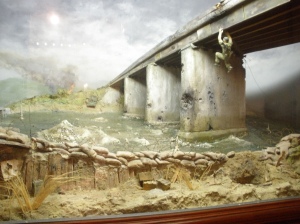
Diorama depicting Colonel John Ripley underneath the Dong Ha bridge located in Bancroft Hall at the United States Naval Academy.
Even when he ordered Colonel Ripley to destroy the Dong Ha Bridge, he did so against the direct wishes of his commanders. However, the reality of over two hundred tanks about to cross the Cua Viet River and invade South Vietnam was too dangerous for him to accept when he had the possibility to prevent it.
In spite of having no food, virtually no sleep and a severe case of dysentery, he faced the opposition of his superiors and stood by his post, directing air, naval and ground operations that salvaged a desperate situation. He continued in this capacity for a full four days until he was ordered back to headquarters for questioning. The physical, psychological and moral stress he faced during this time can hardly be imagined.
Nevertheless, he survived and emerged as one of the greatest examples of “honor and triumph” of the entire war.
The stories of these three heroes and much more are included in Rich Botkin’s Ride the Thunder. This makes it a must-read for all military-buffs, American patriots and especially those who are interested in knowing the true history of the Vietnam War – one not tainted by politically correct historians intent on criticizing America and especially its military.
However, readers should be warned that Mr. Botkin’s book, while less offensive than many military volumes, does have its share of profanity, which he mostly limited to the contents of direct quotes from characters in the book. Similarly, there are references, though not graphic, to those activities that have unfortunately been so closely linked with soldiers throughout history.
Nevertheless, Ride the Thunder is an exciting and highly informative read. No one’s military library is complete without it.
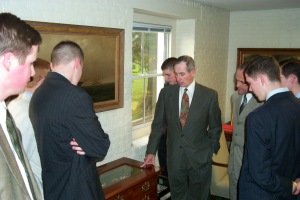
Colonel Ripley with members of TFP Student Action.
A Story of Exceptional Valor and Faith
by Cesar Franco
An old adage states that you only meet two great people in a lifetime. After visiting Col. John W. Ripley, I can say I met my first one.
As Col. Ripley politely invited my colleagues from Tradition, Family and Property Student Action and me into his office on October 31, I felt tremendously honored to meet one of America’s greatest living war heroes — a man who served on active duty for thirty five years in the U.S. Marine Corps.
Before serving two tours in Vietnam, he completed scuba, Ranger, airborne and jump master training. He was also an Exchange Officer to the British Royal Marines, during which time he participated in a Northern Malaysian campaign with the famous Gurkha Rifles.
One Marine Cripples North Vietnamese Invasion
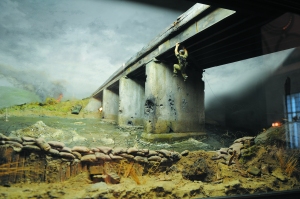
Diorama depicting Colonel John Ripley’s exploits in Dong Ha. It is located in Bancroft Hall at the United States Naval Academy in Annapolis, Maryland.
Col. Ripley is most famous for blowing up the bridge at Dong Ha in Vietnam. He accomplished this act of epic heroism after three days of intense combat, without any food or sleep. A few sips of water from his canteen provided his only sustenance. This superhuman feat crippled the 1972 North Vietnamese Easter invasion which ended in defeat. Thus, the government honored Col. Ripley’s leadership, heroism and self-sacrifice at Dong Ha with a Navy Cross, America’s second highest military decoration.

Members of the American Society for the Defense of Tradition Family and Property (TFP) present Colonel John Ripley with a rosary. "This rosary will not collect dust," said Colonel Ripley in response to this gift.
Col. Ripley is also a man of faith. He attributes the destruction of the Dong Ha bridge to the grace of God and the Blessed Virgin Mary. He related how he felt all physical strength evaporate while placing explosives under the bridge. To continue, he composed a simple rhyming prayer: “Jesus, Mary, get me there… Jesus, Mary, get me there…” He repeatedly said this prayer on the bridge and a supernatural assistance came to his aid at a much-needed time. He stated: “This aid was tangible. It was all-consuming.” His mission would have been impossible without it.
After this operation, Colonel Ripley’s mission was far from over. Unlike Hollywood movies, in which a bridge blows up and everyone lives happily ever after, the North Vietnamese found an alternate route. During the next days of fighting, Life Magazine published a famous picture of Colonel Ripley running as a mortar round blows up nearby. He showed us this amazing photograph during our meeting and many other war relics.
Chivalrous Behavior for a Fallen Soldier
Pointing to his picture, he recounted its exciting story. As the enemy approached within yards, he loaded the dead bodies of five news correspondents into an armored personnel carrier, putting himself in harm’s way. Then the armored personnel carrier left without him.
He was stranded with the limp, lifeless body of his radio man. As the enemy drew closer, he refused to run for cover. Like the knights of old, he preferred to die rather then abandon his fellow soldier’s body. He would not leave his radio man behind even though he was in clear view of the advancing enemy.
He picked up the body of his radio man and walked away very slowly, expecting a bullet to hit him at any moment. Suddenly, some South Vietnamese bodyguards or “cowboys,” as he called them, popped up over a ledge about 100 meters away and addressed him by his Vietnamese nickname, which meant “Captain Crazy.” They told him to duck while they sprayed cover fire allowing him to make a desperate 100-meter dash for safety. Smiling, Colonel Ripley recalled how he ran those 100 meters in 3 seconds!
The Four Bullets
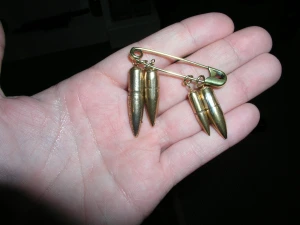
TFP member holds the three bullets that nearly took the life of Colonel Ripley. The fourth one he found on the Island of Iwo Jima.
While showing us some of his war relics, he pulled something out of his pocket. It was a brass-colored safety pin that connected four bullets. Grinning, he said: “I am personally acquainted with three of these.” One bullet pierced through the deck of the chopper in which he was flying and struck a magazine clip on his ammo belt, barely stopping its entry into his abdomen!
“When I’m having a bad day,” he said, “I pull these out of my pocket and say to myself, no, it’s not that bad… I’m not having such a bad day.”
He also showed us a neatly arranged collection of stamps he had acquired from a captured North Vietnamese postal worker.
What Is True Leadership?
The most interesting part of our meeting was when Colonel Ripley explained the essence of a true leader is one who sets the example and shows his troops how to act, rather than tell them what to do from a desk and ask them to report back. Colonel Ripley is one such leader. He never shied away from action, but always preferred to be on the front lines with his men.
In addition to being deadly on the battlefield, this tough marine is also lethal in the realm of ideas. After hearing about
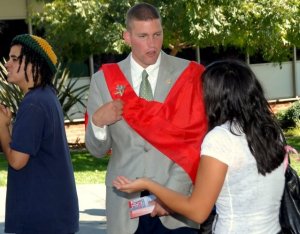
TFP member John Miller debates the Traditional Marriage issue with a student at Mount San Antonio College in Walnut California.
the TFP Student Action debates on university campuses, he described the wonderful time he had appearing on Crossfire to debate a female Air Force general defending the need for women in the military. She could not stand up against the bulletproof logic of Colonel Ripley’s real life combat experience.
Tribute, Respect and Admiration
Colonel Ripley deserves our tribute, respect and admiration.
He taught us that to be a true leader one must have faith in God and Our Lady. He explained how being a leader means setting the example. Moreover, his heroic actions at Dong Ha speak even louder than his words.
It was truly an honor and privilege to meet this model soldier, a man with profound zeal for the Catholic Church and high ideals for which he is willing to give his life. My TFP colleagues and I will never forget him.
 In today’s increasingly troubled society, there is a desperate need for role models, especially among the youth. Colonel John W. Ripley, USMC is an authentic American hero and a true role model, whose life is worthy of admiration and emulation.
In today’s increasingly troubled society, there is a desperate need for role models, especially among the youth. Colonel John W. Ripley, USMC is an authentic American hero and a true role model, whose life is worthy of admiration and emulation.
Known for his impressive heroics during the Vietnam War, Colonel Ripley earned the Navy Cross, along with numerous other awards. His legendary career in the United States Marine Corps is well-known, but now, for the first time ever, a new book that covers his whole life — from his adventure-filled boyhood in rural Southwestern Virginia to his days at the U.S. Naval Academy, his tours of duty in Vietnam, his post retirement years and finally, the final days before his death — is soon to be released.
* * * * *
In An American Knight: The Life of Colonel John W. Ripley, USMC, TFP author Norman Fulkerson succeeds in telling the fascinating story of this legendary Marine, whose ancestors fought in every American conflict since the Revolutionary War.
In An American Knight, Norman Fulkerson shows:
**Colonel Ripley’s deep Catholic Faith, his love for his children and his devotion to his wife, Moline.
**His many struggles, one of the last being his liver transplant, described by his surgeon as the “most dramatic” one in history.
**The ultimate warrior whose Faith, discipline and morals provided him the strength necessary to vanquish enemies in battle.
**The gallantry of a man who faced public opinion and political correctness when he opposed homosexuals in the military and women in combat.
**How he transformed youthful energy into a determination and ultimately success at the US Naval Academy.
**How he stopped a Communist tank column and 30,000 NVA dead in their tracks.
This makes An American Knight a splendid and inspiring tribute to one of America’s greatest fighting men, whose legacy will deeply mark the souls of all those who love the virtues of the medieval knight: Faith, honor, heroism and integrity.
* * * * *
From the foreward by General James Livingston:
“He [Colonel Ripley] saw accepting risk as part of his job as a Marine. He expressed this while speaking to a group of young men considering a career in the Corps. “Risk comes with the job,” he told them. “If you are not comfortable with risk, you need to get into a new line of work.”
“These and many of Colonel Ripley’s other qualities are enumerated in An American Knight. Thus, I recommend it strongly. I hope my thoughts will help its readers to gain a better appreciation for this Marine who will doubtlessly be remembered as one of the greatest men ever to honor the Corps.”
 General James Livingston
General James Livingston
Medal of Honor Recipient
———————————————————————————————————————————————
Here’s what they’re saying about An American Knight:
“I knew Colonel John W. Ripley like a brother for 42 plus years, but the facts are that I learned still more about my Marine buddy from Norman Fulkerson’s book… Norman goes into family and early life details that started this Marine on his most successful Marine career as well as John’s perception of the obligation and performance of his duties in uniform. This is a “must read” for all desiring to be a leader, especially those desiring to lead Marines.”
 Colonel Wesley Lee Fox, USMC (Ret.)
Colonel Wesley Lee Fox, USMC (Ret.)
Medal of Honor Recipient
Author of Marine Rifleman: Forty-three Years in the Corps and Courage and Fear
——————————————————————————————————————————————–
“In his new book An American Knight, Norman Fulkerson has vividly captured the extraordinary active journey in life of Colonel John Ripley. In this first ever biography of a truly legendary Marine, the reader will see a man of many images; a gentle person who was comfortable with people of all stations of life, a caring father, a faithful husband, and a Marine capable of doing the seemingly impossible when I ordered him to destroy the Dong Ha Bridge.
“Because of his compelling and uncommon level of service to this great nation, Colonel John Ripley truly deserves to be held up as a role model for all to follow. Norman Fulkerson’s book will help to insure this.”
 Colonel Gerald Turley, USMC (Ret.)
Colonel Gerald Turley, USMC (Ret.)
Author of The Easter Offensive
—————————————————————————————————————————————-
“An American Knight by Norman Fulkerson is an outstanding tribute to one of the finest men to ever wear a uniform of the United States of America.”
 Commander Paul Galanti, USN (Ret.)
Commander Paul Galanti, USN (Ret.)
POW for seven years
* * *
To pre-order your copy of An American Knight: The Life of Colonel John W. Ripley, USMC, by Norman Fulkerson, visit www.americanknight.org or call 1-888-317-5571.




